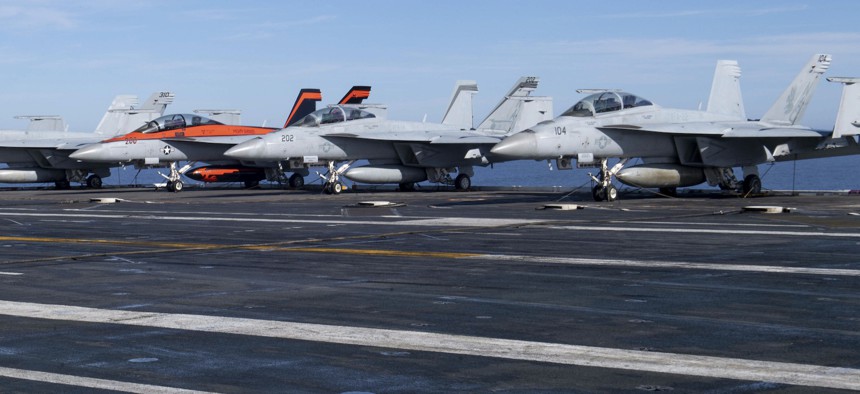
F/A-18F Super Hornets and an F/A-18E Super Hornet, from Carrier Air Wing (CVW) 17, rest on the flight deck of the aircraft carrier USS Nimitz in 2022. U.S. Navy / Mass Communication Specialist 3rd Class Jared Mancuso
How many Super Hornets are ready to fly? The Navy’s tracking tools disagree
Congressional Budget Office examined two systems that use different metrics to track F/A-18 availability.
Two key tools the Navy Department is using to monitor its battle to raise availability rates for its F/A-18 Super Hornets don’t always see eye-to-eye, the Congressional Budget Office found.
The CBO looked at the monthly availability rates from March 2017 to September 2021 for hundreds of Super Hornets as reported by two databases: the Decision Knowledge Programming for Logistics Analysis and Technical Evaluation system, or DECKPLATE; and the Aviation Maintenance Supply Readiness Report, or AMSRR.
The databases determine availability in different ways. DECKPLATE, which is used by maintenance and logistics troops, notes the availability rate and actual flying hours of an aircraft in a month, whereas AMSRR is a daily assessment by commanders on whether an aircraft can conduct missions at some point that day, according to a CBO report released Monday.
While the older DECKPLATE database is “the official tracking program for Navy and Marine Corps aircraft,” the Navy told CBO that the newer AMSRR system “better describes the availability of the department’s aircraft.”
The CBO found the AMSRR shows a higher average availability rate for Super Hornets than the DECKPLATE database, and that AMSRR’s rates are better at predicting aircraft flying hours.
“Although DECKPLATE’s availability rates are supposed to reflect the actual hours aircraft were available, CBO found what appear to be data errors in DECKPLATE. As a result, AMSRR’s availability rates more closely correlated with the actual hours that Super Hornets were flown.”
While both systems had errors in the data, CBO found more in DECKPLATE, and said those mistakes “reduce its value in predicting flying hours.”
“From 2017 to 2021, Super Hornets reported as 100 percent available in DECKPLATE were much more likely to not fly in a month than those reported as 100 percent available in AMSRR (59 percent of the time versus 2 percent). In addition, Super Hornets reported in DECKPLATE as having zero availability were more likely to fly than aircraft with that designation in AMSRR (14 percent of the time versus 4 percent),” the report said about the errors.
The Navy “told CBO that the department is working to improve the quality of its aircraft availability data. If the data in DECKPLATE were more accurate, that system’s measurements of availability might match actual flying hours just as well as, or even better than, AMSRR’s measurements do,” the report said.
The poor availability rates of Super Hornets have been an ongoing concern of the Navy for years, and Chief of Naval Operations Adm. Mike Gilday has made improving them a key focus. He has highlighted their efforts to increase the fleet’s rate, which was at 55 percent in 2019, in the “Get Real, Get Better” initiative, which launched in 2022. The service brought the rate up to over 80 percent in less than a year, the Navy said.
A February CBO report on the availability of the F/A-18 fleet, using data from DECKPLATE, found that the F/A-18E/F Super Hornet and the older F/A-18C/D Hornet “experienced sharper and steeper drops in availability than the rest of the Department of the Navy’s fleet,” from the mid-2000s to the mid-2010s. The report also found Super Hornet availability rates were declining faster than those of older Hornet variants when they were the same age.
“Once aircraft age is considered, Super Hornets underperformed predecessor Hornets, with lower availability rates than the earlier generation of F/A-18C/Ds of the same age. Those differences are statistically significant,” the CBO said.
This week’s report also found that while the fleet’s annual availability rates increased from 2018 to 2021, the hours each aircraft flew annually actually went down during the2017 and 2021 timeframe.
“That result, which may seem counterintuitive, occurred because total flying hours for Super Hornets became more evenly distributed across the fleet during that period. Fewer aircraft did not fly at all; in addition, fewer aircraft flew large numbers of hours,” the report said. “Total flying time decreased, but the percentage of aircraft that flew increased, consistent with AMSRR’s reported increase in availability rates.”
